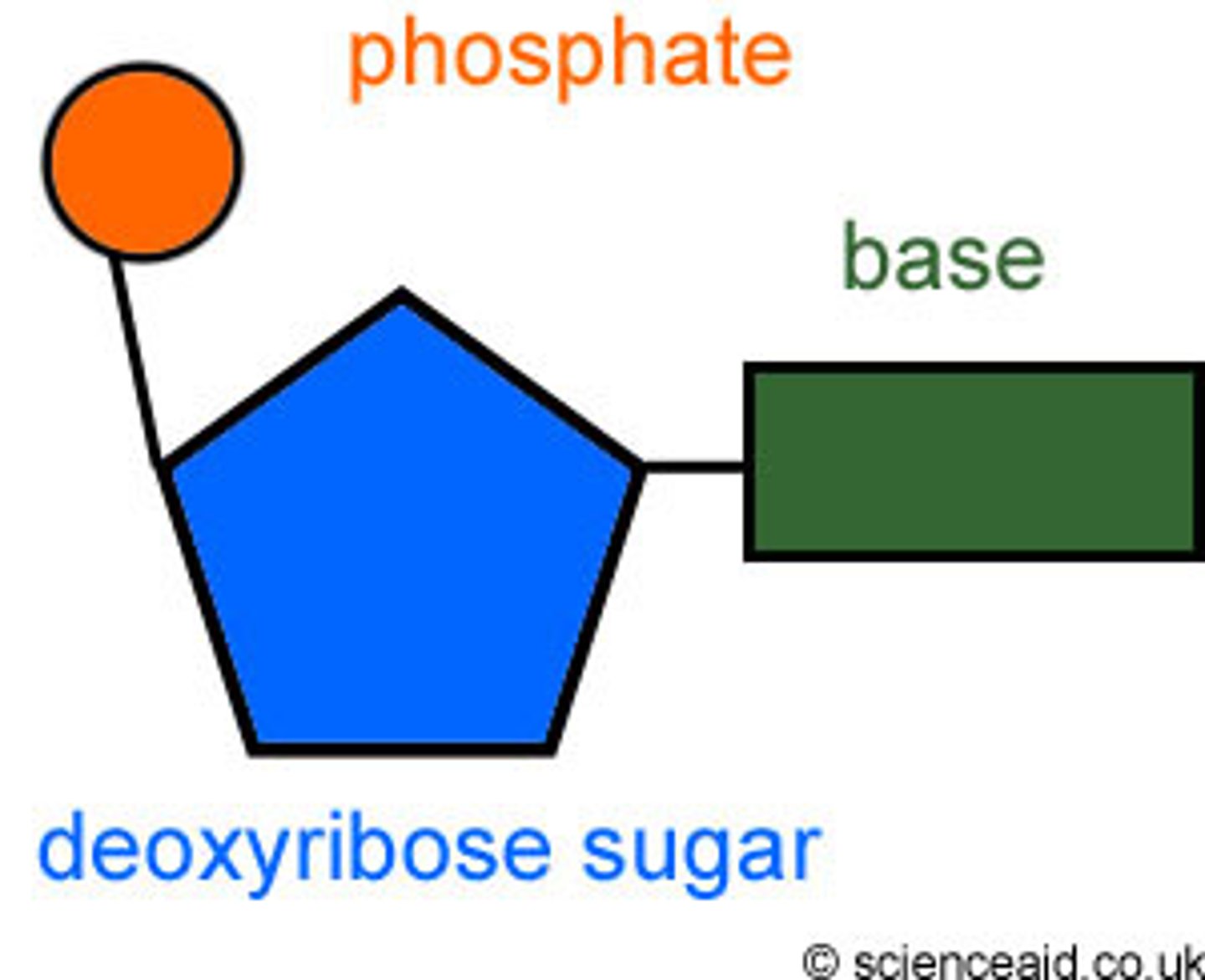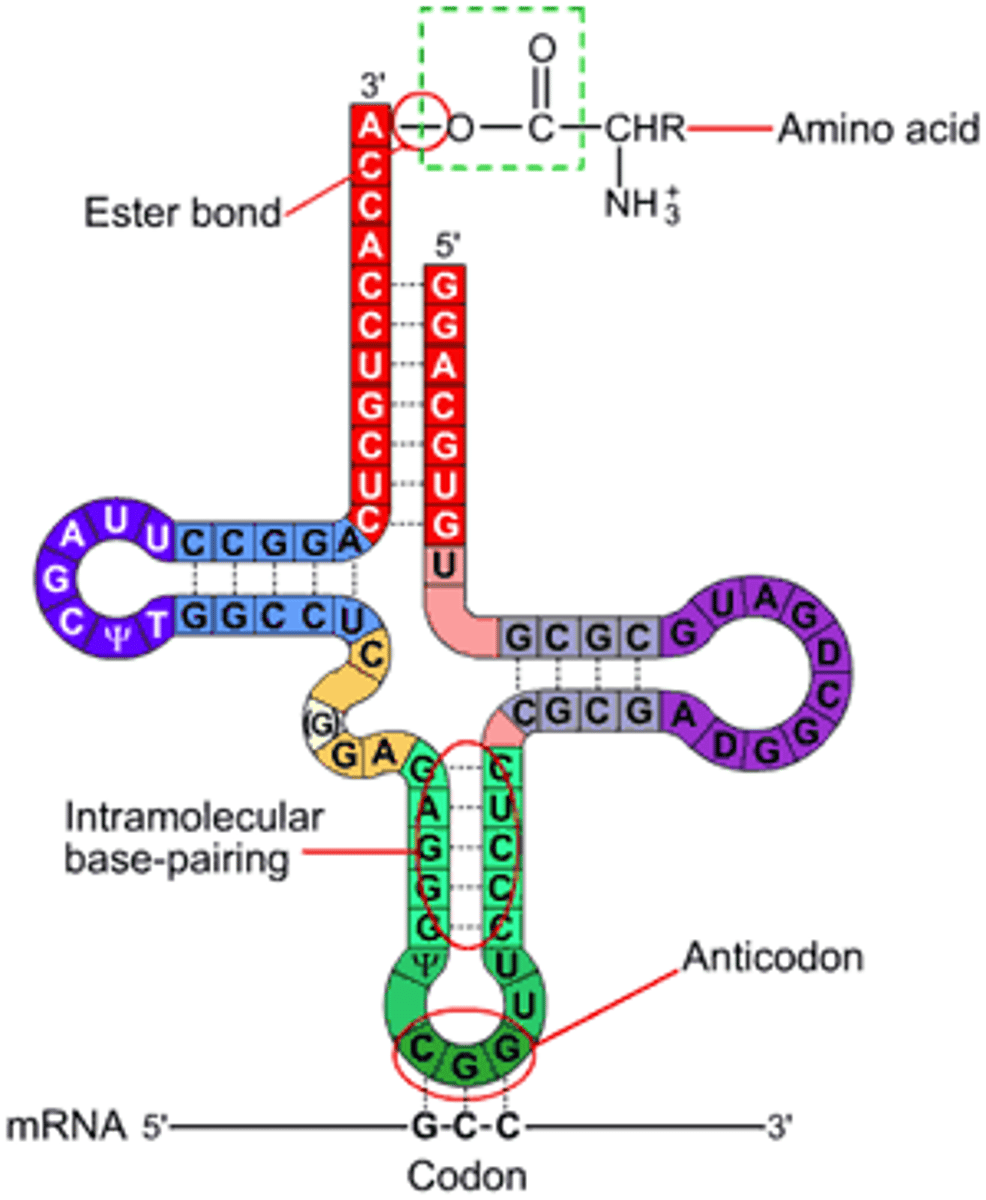IB Biology - Biomolecules: Nucleic Acids
1/35
There's no tags or description
Looks like no tags are added yet.
Name | Mastery | Learn | Test | Matching | Spaced |
|---|
No study sessions yet.
36 Terms
Nucleotides
-recurring monomeric units that make up nucleic acids
Nucleotide structure
-a pentose sugar, phosphate group and a nitrogenous base
-both the phosphate group and nitrogenous base are attached to the 5-carbon pentode sugar
-the nitrogenous base is attached to the 1' - carbon atom (right point)
-the phosphate group is attached to the 5' carbon atom (left point)

Strand formation
-nucleotide monomers are linked into a single strand via condensation reactions
-the phosphate group of one nucleotide attaches to the sugar of another nucleotide (at the 3'-hydroxyl position)
-this results in a covalent phosphodiester bond forming between the 2 nucleotides
Condensation reaction
a reaction in which two molecules become covalently bonded to each other with water produced as a by product
Formation of long polynucleotide strands
-the result of successive condensation reactions
-the sugar and the phosphate form a backbone while the nitrogenous bases extend out from this strand
Base sequence
nucleic acids are composed of a combination of 4 nitrogenous bases
nitrogenous bases can pair up (purine:pyridimine) via hydrogen bonding to create a complementary sequence (diff instructions, diff sequence)
-guanine & adenine (double ringed) are double-ringed purine bases
-cytosine & thymine / uracil (single ringed) are single-ringed pyrimidine bases
thymine & uracil are chemically simimlar molecules: thymine is used in DNA, while uracil is used in RNA
Benefits of base pairing
-allows for the genetic material to be replicated (one strand acts as a template for the synthesis of a new strand)
-allows for the genetic instructions to be expressed within the cell (a complementary transcript can be produced from the template
Francis Crick & James Watson
deduced the structure of DNA in 1953 via data from other scientists and making models
Rosalind Franklin & Maurice Williams
produced very clear x-ray diffraction photos of DNA. From these Crick and Watson determined DNA was formed from 2 strands wound into a double helix, linked by pairs of bases
Erwin Chargraff
discovered that the numbers of adenine and thymine molecules in any length of DNA were equal, as was cytosine and guanine. This allowed Crick and Watson to deduce that adenine must pair with thymine and cytosine must pair with guanine
Tetranucleotide hypothesis
-early theory that DNA structure's 4 bases may have occured in a repeating sequence
-according to this theory (introduced by Phoebus Levene in 1909), DNA was composed of only 4 nucleotides per molecule, with each of the bases present in equal amounts and positioned exactly
-the theory was falsified by Chargraff's data
Problem with tetranucleotide hypothesis
it did not allow for variability in base sequence and therefore could not support the hypothesis that DNA was the genetic material of the cell
Chargraff's findings
-in 1984 Chargraff demonstrated that the frequency of the 4 bases was not equal
-different species had different base compositions, supporting the proposition that DNA was the genetic material (as later confirmed by Hershey & Chase)
-Specific purines and pyrimidines occurred in equal rations (A=T & G=C), suggesting the possibility that these bases occur in pairs
Chargraff's procedure
-Chargraff conducted his experiment using DNA sequences from a number of different species
-Chargraff hydrolysed a DNA sequence with an acid and then used paper chromatography to seperate out the 4 nitrogenous bases
-he then used UV spectrophotometry to quantitate the amount of each base, that the amounts were not consistent across the 4 bases
Purine-puridimine bonding as a component of DNA helix stability
-A pairing of two purines would be energetically unfavourable as the two molecules would be too close together and repulse each other
-A pairing of two pyrimidines would be energetically unfavourable as the two molecules would be too far apart to form stable hydrogen bonds
The bonding of a purine to a pyrimidine ensures the sugar-phosphate backbones remain separated by a constant width throughout the DNA molecule
-Adenine pairs with thymine via two hydrogen bonds, while cytosine pairs with thymine via three hydrogen bonds
-While alternative purine : pyrimidine pairings would maintain a constant diameter, the atomic configurations would not be favourable for hydrogen bonding
DNA vs RNA
there are 2 types of nucleic acids present in cells
-DNA is a more stable molecule that functions as the master template for all genetic instructions
-features:
sugar: deoxyribose (1 less O at 2' position)
base: thymine
strands: double stranded
-RNA is a more versatile molecule and functions to transfer the genetic information for coding
-features:
sugar: ribose
base: uracil
strands: single stranded
RNA
the nucleic acid used to express the genetic instructions within a cell (involved protein synthesis)
RNA Structure
-single stranded molecule produced from a DNA template (gene) via condensation of nucleotide monomers
-the order of the nucleotide monomers is determined by base pairing (the RNA sequence will be complementary to the gene sequence)
Types of RNA
3 main types involved in protein synthesis:
-messenger (mRNA)
-Transfer (tRNA)
-Ribosomal (rRNA)
while mRNA is a linear molecule, complementaty base pairing can allow tRNA and rRNA to twist and form loops
Messenger RNA (mRNA)
the transcript copy of the DNA instructions (it encodes the protein sequence)

Transfer RNA (tRNA)
carries the protein subunits (amino acids) to the mRNA transcript

Ribosomal RNA (rRNA)
provides the catalytic activity for combining the amino acids according to the mRNA sequence

DNA
-the nucleic acid that is used to pass hereditary information (genes) between generations of cells
-it also contains the set of instructions that are used to produce proteins via RNA (it is the cell's blueprint
DNA Structure
Unlike RNA, a DNA molecule is composed of 2 strands held together by hydrogen bonding between base pairs
-adenine pairs with thymine via two hydrogen bonds, while guanine and cytosine pair via 3 hydrogen bonds
in order to ensure the bases are facing each other and able to pair, the 2 strands must run in opposite directions (antiparallel)
-the DNA molecule forms a ladder structure: the 2 backbones being struts, the base pairs acting as rungs
as the antiparallel chains lengthen, the strands will arrange themselves into the most stable energy configuration
-this results in the double stranded DNA forming a double helix (10-15 bases per twist)
Benefits of DNA being double stranded
helps maintain the fidelity of the base sequence during replication, as one strand acts as a template for the other strand
Directionality of RNA & DNA
-the carbon atoms in the pentose sugar are numbered, with the base attached to the 1' carbon and the phosphate attached to the 5' carbon
-nucleotides form long strands when the phosphate group of one nuceotide attaches to the sugar of another (at the 3' hydroxyl position
the 5' to 3' linkages in the sugar-phosphate backbone can be used to assign directionality to the DNA strand
-as double stranded DNA is antiparallel, one strand runs from 5' to 3' while the other strand runs from 3' to 5'
Strand ends
-each strand has a 5' end and a 3' prime end.
-these indicate the free ends where another nucleotide could be attached
-nucleic acids always work in a 5' to 3' direction
Genetic information
-nucleic acids are used to store the genetic information that acts as a blueprint for the cell
-while RNA may have been the first genetic material to evolve, DNA is now th principle data storage molecule due to its superior chemical stability ( double helical structure
DNA is used as the genetic material for all living organisms
-some viruses use RNA as their genetic material, however as they cannot undergo independent metaboism they are not considered living
Diversity of DNA base sequences
the genetic information stored by DNA is encoded in the base sequence of the nucleotide chain
-as DNA is composed of 4 bases, a DNA strand of x length would result in 4x different sequences
-this means that even a sequence as short as 10 bases could give rise to over 1 million combinations
-as the median length of a gene sequence is roughly 24 kilobases, there is a huge diversity of possible ase sequences for any given gene
DNA's storage capacity
because DNA is a very compact and stable molecule that has a limitless capacity for storing information, scientists are endeavouring to encode digital information as genetic sequences
Evidence from Hershey & Chase experiment for DNA as the genetic material
In the mid-twentieth century, scientists were still unsure as to whether DNA or protein was the genetic material of the cell
-It was known that some viruses consisted solely of DNA and a protein coat and could transfer their genetic material into hosts
In 1952, Alfred Hershey and Martha Chase conducted a series of experiments to prove that DNA was the genetic material
-Viruses (T2 bacteriophage) were grown in one of two isotopic mediums in order to radioactively label a specific viral component
•Viruses grown in radioactive sulfur (35S) had radiolabelled proteins (sulfur is present in proteins but not DNA)
•Viruses grown in radioactive phosphorus (32P) had radiolabeled DNA (phosphorus is present in DNA but not proteins)
The viruses were then allowed to infect a bacterium (E. coli) and then the virus and bacteria were separated via centrifugation
•The larger bacteria formed a solid pellet while the smaller viruses remained in the supernatant
The bacterial pellet was found to be radioactive when infected by the 32P-viruses (DNA) but not the 35S-viruses (protein)
•This demonstrated that DNA, not protein, was the genetic material because DNA was transferred to the bacteria
Nucleosome
in eukaryotes, DNA is packaged with histone proteins to create a compacted structure called a nucleosome
-nucleosomes help to supercoil the DNA, resulting in a greatly compacted structure that allows for more efficient storage
-supercoiling helps to protect the DNA from damage and also allows chromosomes to be mobile during mitosis and meiosis
Organisation of eukaryotic DNA
-the DNA is complexed with 8 histone proteins (an octamer) to form a complex called a nucleosome
-nucleosomes are linked by an additional histone protein (H1 histone) to form a string of chromatosomes
-these then coil to form a solenoid structure (approx. 6 chromatosomes per turn) which is condensed to form a 30nm fibre
-these fibres then form loops, which are compressed and folded around a protein scaffold to form chromatin
-chromatin will then supercoil during cell division to form chromosomes that are visible (when strained) under microscope
Nucleosome structure
a nucleosome consists of a molecule of DNA wrapped around a core of 8 histone proteins (an octamer)
-the negatively charged DNA associates with positively charged amino acids on the surface of the histone proteins
-the histone proteins have N-terminal tails which extrude outwards from the nucleosome
-during chromosomal condensation, tails from adjacent histone octamers link up and draw the nucleosomes closer together

Conservation of genetic code of all life forms as LUCA evidence
The totality of all codon combinations and the amino acids represented by each is known as the genetic code
-The genetic code is considered universal - all living organisms on Earth use the exact same code (with some minor exceptions)
-The conservation of the genetic code across all life forms is considered evidence that all living organisms evolved from a universal common ancestor
Codons
DNA stores the instructions for protein production in triplets of bases called codons
-each codon codes for a specific amino acid, the order of codons in a gene sequence determines the order of amino acids in a polypeptide chain